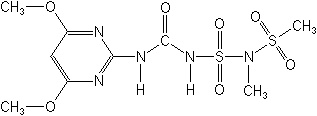-
Common NameAmidosulfuron
-
中文通用名酰嘧磺隆
-
IUPAC1-(4,6-dimethoxypyrimidin-2-yl)-3-mesyl(methyl)sulfamoylurea
-
CASN-[[[[(4,6-dimethoxy-2-pyrimidinyl)amino]carbonyl]amino]sulfonyl]-N-methylmethanesulfonamide
-
CAS No.120923-37-7
-
Molecular FormulaC9H15N5O7S2
-
Molecular Structure
-
Category
-
ActivityHerbicide.
Amidosulfuron is a systemic herbicide intended for spring control of cleavers (Galium aparine). It is primarily absorbed by the leaves of plants but is also absorbed through the roots. Weeds die within six weeks of treatment. Amidosulfuron may be applied from early post-emergence of the crop until GS 49. Cleavers are controlled from emergence through to budding. The product is active at temperatures as low as 2oC but may only stunt the growth of weeds rather than kill them at these temperatures. The application rate in cereals may be reduced if amidosulfuron is tank-mixed with other broadleaf herbicides. The company recommends only one application per season.
In field trials, amidosulfuron has been shown to be safe on crops grown in rotation with cereals, including oilseed rape, sugar beet and sunflowers, which are sensitive to the product. -
CropUse
Crop uses:
wheat, barley, oats, rye, triticale, flax, linseeds
Winter cereals:
30 g ai/ha
Spring cereals:
30 g ai/ha
Pastures:
45 g ai/ha
Flax:
30 g ai/ha
Linseed
30 g ai/ha
-
PremixMCPA+Amidosulfuron
Florasulam+Amidosulfuron
Amidosulfuron+iodosulfuron-methyl-sodium
Water dispersible granules. Premix Parters: bifenthrin; tralomethrin.Type
AI concn
Water-dispersible granule (WG)
50% (w/w) 75% (w/w)
-
Physical PropertiesFine, white powder. Molecular weight: 369.4 g/mol;Melting point 160-163℃. Density approx. 1.5 g/cm3.
-
Toxicology(Rat): Oral LD50 >5000 mg/kg. Dermal LD50 >5000 mg/kg.
-
Environmental ProfileWATER SOLUBILITY: 9 mg/l at 20℃(pH 5.8)
Mallard duck
LD50 >2,000 mg/kg Rainbow trout [96 hrs] LC50 >320 mg/litre
Bobwhite quail
LD50 >2,000 mg/kg
Fate in :
Fate in soil:
Amidosulfuron is degraded by microbes in the soil; the half-life is less than 30 days. Degradation in soil is unaffected by soil type and pH. It has low soil mobility. Fate in aquatic systems:
Amidosulfuron has a half-life of 29-120 days in natural systems. Degradation is faster in systems with high organic content.
-
Transport InformationSignal Word:CAUTION; Hazard Class:III (Slightly hazardous)
Porduct NewsMore
Bayer develops alternative to glyphosate herbicide
Colombia’s Constitutional Court bans chlorpyrifos
ADAMA Canada moves forward with lambda-cyhalothrin sales for 2023
Mexico: Import of glyphosate drops from 16,500 tons to 8,200 tons
Glyphosate prices drop 30% in Argentina
One year extension of EU glyphosate approval failed to pass in the latest meeting
Palmer amaranth in two southern U.S. states now resistant to S-metolachlor
Related CompaniesMore
Jiangsu Repont Agrochemical Co., Ltd.
Country: China
Chlorimuron-ethyl Bensulfuron-methyl Thifensulfuron-methyl Ethxosulfuron Flucarbazone Carfentrazone Florasulam Metribuzin Flumetsulam Flazasulfuron.
Hangzhou Tianlong Biotechnology Co., Ltd.
Country: China

 0
0 Subscribe
Subscribe
